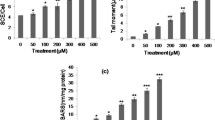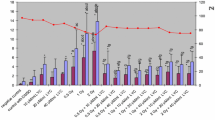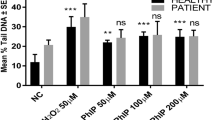Abstract
Dietary polyphenolics, such as curcumin, have shown antioxidant and anti-inflammatory effects. Some antioxidants cause DNA strand breaks in excess of transition metal ions, such as copper. The aim of this study was to evaluate thein vitro effect of curcumin in the presence of increasing concentrations of copper to induce DNA damage in murine leukocytes by the comet assay. Balb-C mouse lymphocytes were exposed to 50 μM curcumin and various concentrations of copper (10 μM, 100 μM and 200 μM). Cellular DNA damage was detected by means of the alkaline comet assay. Our results show that 50 μM curcumin in the presence of 100–200 μM copper induced DNA damage in murine lymphocytes. Curcumin did not inhibit the oxidative DNA damage caused by 50 μM H2O2 in mouse lymphocytes. Moreover, 50 μM curcumin alone was capable of inducing DNA strand breaks under the tested conditions. The increased DNA damage by 50 μM curcumin was observed in the presence of various concentrations of copper, as detected by the alkaline comet assay.
Similar content being viewed by others
References
Ahsan H, Hadi SM, 1998. Strand scission in DNA induced by curcumin in the presence of Cu (II). Cancer Lett 124: 23–30.
Ahsan H, Parveen N, Khan UN, Hadi SM, 1999. Pro-oxidant, anti-oxidant and cleavage activities on DNA of curcumin and its derivatives demethoxycurcumin and bisdemethoxycurcumin. Chem Biol Interac 121: 161–175.
Antunez LMG, Araujo MCP, Dias FL, Takahashi CS, 1999. Modulatory effects of curcumin on the chromosomal damage induced by doxorubicin in Chinese hamster ovary cells. Teratogenesis Carcinog Mutagen 19: 1–8.
Araujo CAC, León LL, 2001. Biological activities ofCurcuma longa L. Mem. Inst. Oswaldo Cruz, Río de Janeiro 96: 723–728.
Araujo MCP, Días FL, Takahashi CS, 1999. Potentiation by turmeric and curcumin of y-radiation-induced chromosome aberration en Chinese hamster ovary cells. Teratogenesis, Carcinog Mutagen 19: 9–18.
Araujo MCP, Antunez LMG, Takahashi CS, 2001. Protective effect of thiourea, a hydroxyl-radical scavenger, on curcumin-induced chromosomal aberrations in an in vitro mammalian cell system. Teratogenesis Carcinog Mutagen 21: 175–180.
Avishai N, Rabinowitz C, Rinkevick B, 2003. Use of the comet assay for studying environmental genotoxicity. Environ Mol Mutagen 42: 155–165.
Banu BS, Ishaq M, Danadevi K, Padmavathi P & RY Ahuja. 2004. DNA in leukocytes of mice treated with Cu sulfate. Food and Chemical. Toxicology 42: 1931–1936.
Barik A, Mishra B, Shen L, Mohan H, Kadam RM, Dutta S, Zhang HY & KI Priyadarsini. 2005. Evaluation of a new copper (II)-curcumin complex as superoxide dismutase mimic and free radical reactions. Free Radic Biol Med 39: 811–822.
Baum L, Ng A, 2004. Curcumin interaction with copper and iron suggests one possible mechanism of action in Alzheimer’s disease animal models. J Alzheimers Dis 6: 367–377; discussion 443–449.
Belpaeme K, Cooreman K, Kirsch-Volders M, 1998. Development and validation of the in vivo alkaline comet assay for detecting genomic damage in marine flatfish. Mutat Res 415: 167–184.
Blasiak J, Trzeciak A, Kowalik J, 1999a. Curcumindamages DNA in human gastric mucosa cells and lymphocytes. J Environ Pathol Toxicol Oncol 18: 271–276.
Blasiak J, Trzeciak A, Malecka- Panas E, Drzewoski J, Iwanieko T, Szumiel WM, 1999b. DNAdamage and repair in human lymphocytes and gastric mucosa cells exposed to chromium and curcumin. Teratogenesis Carcinog Mutagen 19: 19–31.
Cervantes-Cervantes MP, Calderon-Salinas JV, Albores A, Munoz-Sanchez JL, 2005. Copper increases the damage to DNA and proteins caused by reactive oxygen species. Biol Trace Elem Res 103: 229–248.
Choudhuri T, Pal S, Agwarwal ML, Das T, Sa G, 2002. Curcumin induces apoptosis in human breast cancer cells through p53-dependent Bax induction. FEBS Lett 512: 334–340.
Collins AR, 2004. The comet assay for DNA damage and repair: Principles, applications and limitations. Mol Biotechnol 26: 249–261.
Collins AR, Dusinská M, Gedik CM, Stetina R, 1996. Oxidative damage to DNA: Do we have a reliable biomarker? Environ Health Perspectives 104: 465–469.
Djuzenova ChS, Schindler D, Stopper H, Hoehm H, Flentje M, Oppitz U, 1999. Identification of ataxia heterozygotes, a cancer-prone population, using the single-cell gel electrophoresis (Comet) assay. Lab Invest 79: 699.
Eigner D, Scholz D, 1999.Ferula asafoetida andCurcuma longa in traditional medical treatment and diet in Nepal. J Ethno Pharmacol 67: 1–6.
el Hamss R, Analla M, Campos-Sanchez J, Alonso-Moraga A, Munoz-Serrano A, Idaomar M, 1999. Adose-dependent anti-genotoxic effect of turmeric. Mutat Res 446: 135–139.
Gaetke LM, Chow CK, 2003. Cu toxicity, oxidative stress, and antioxidant nutrients. Toxicology 189: 147–163.
Galati G, Sabzevari O, Wilson JX, O’Brien PJ, 2002. Prooxidant activity and cellular effects of the phenoxyl radicals of dietary flavonoids and other polyphenolics. Toxicology 177: 91–104.
Gescher JA, Sharma AR, Steward PW, 2001. Cancer chemoprevention by dietary constituents: a tale of failure and promise. The Lancet Oncol 2: 371–379.
Hayashi M, Kuge T, Endoh D, Nakayama K, Arihawa J, Tahazawa A, Okuit T, 2000. Hepatic Cu accumulation induces DNA strand breaks in the liver cells of Long-Evans Cinnamon strain rats. Biochem Biophys Res Commun 276: 174–178.
Kelly MR, Xu J, Alexander KE, Loo G, 2001. Disparate effects of similar phenolic phytochemicals as inhibitors of oxidative damage to cellular DNA. Mutat Res 485: 309–318.
Kobayshi H, Sugiyama Ch, Morikawa Y, Hayasi M, Sofuni T, 1995. A comparison between manual microscopic analysis and computerized image analysis in the single cell gel electrophoresis assay. MMS Commun 3: 103–115.
Mukhopadhyay MJ, Saha A, Mukherjee A, 1998. Studies on the anticlastogenic effect of turmeric and curcumin on cyclophosphamide and mitomicyn Cin vivo. Food Chem Toxicol 36: 73–76.
Shukla Y, Arora A, Taneja P, 2002. Antimutagenic potential of curcumin on chromosomal aberrations in Wistar rats. Mutat Res 515: 197–202.
Singh NP, McCoy MT, Tice RR, Schneider EL, 1988. A simple technique for quantitation of low levels of DNA damage in individual cells. Exp Cell Res 175: 184–191.
Sugiyama Y, Kawakishi S, Osawa T, 1996. Involvement of the beta-diketone moiety in the anti-oxidative mechanism of tetrahydrocurcumin. Biochem Pharmacol 52: 519–525.
Tice RR, Agurell E, Anderson D, Burlinson B, Hartmann A, Kabayashi H, et al. 2000. Single cell gel/Comet assay: Guidelines for in vitro and in vivo genetic toxicology testing. Environ Mol Mutagen 35: 206–221.
Vijayalaxmi, 1980. Genetic effects of turmeric and curcumin in mice and rats. Mutat Res 79: 125–132.
Yamashita N, Murata M, Inoue S, Burkitt MJ, Milne L, Kawanishi S, 1998. α-Tocopherol induces oxidative damage to DNA in the presence of copper (II) ions. Chem Res Toxicol 11: 855–862.
Yoshino M, Haneda M, Naruse M, Htay HH, Tsubouchi R, Qiao SL, et al. 2004. Prooxidant activity of curcumin: copper-dependent formation of 8-hydroxy-20-deoxyguanosine in DNA and induction of apoptotic cell death. Toxicol in Vitro 18: 783–789.
Author information
Authors and Affiliations
Corresponding author
Rights and permissions
About this article
Cite this article
Urbina-Cano, P., Bobadilla-Morales, L., Ramírez-Herrera, M.A. et al. DNA damage in mouse lymphocytes exposed to curcumin and copper. J Appl Genet 47, 377–382 (2006). https://doi.org/10.1007/BF03194648
Received:
Accepted:
Issue Date:
DOI: https://doi.org/10.1007/BF03194648




